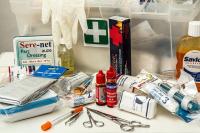Pet First Aid Kits
Having a pet first aid kit could save the life of your dog or cat if he is injured or ingests something and you cannot get to a veterinarian immediately. While each item requires a certain amount of training and instruction to use properly, these top ten items are easy to use with practice!
- Thermometer and K-Y Jelly. Your thermometer should be digital, plastic, and have a 15-second reading time and be lubricated with the K-Y Jelly prior to attempting to take a rectal temperature reading.
- Wire-cutters and tweezers. These should be small, to remove fishhooks, wire, etc. The tweezers, ideally, should be sturdy and metal with serrated edges.
- Bandaging materials. Non-adhesive bandages, gauze pads, rolled cotton or gauze wrap, and waterproof cloth tape. Bandaging pads should be 2 or 4 inches square, depending on the size of your pet, and wraps should be up to 4 inches wide. Sanitary napkins can be used to help absorb excessive bleeding.
- Blunt-tipped scissors for cutting hair and/or bandages or bandaging materials.
- Oral syringes in both a 1 ml and 20 ml capacity. This can be used to give medication or water to your pet in the event that serious dehydration is a concern. Even better, keep some powdered Pedialyte in your kit to make into an oral solution to prevent life-threatening dehydration.
- Disinfecting solutions. Two types are needed. The first is iodine or chlorhexidine disinfecting solution to be used to clean and sterilize skin wounds. The second is contact lens or saline solution to flush out eyes and/or wounds around the eyes.
- Hydrogen Peroxide solution can be used to induce vomiting and/or clean wounds.
- Antibiotic ointment and cortisone ointment or spray (better than cream). These may be needed for minor wounds (antibiotic) or stings/bug bites (cortisone). Baking soda can also be helpful in soothing stings.
- Diphenhydramine/Benadryl 25 mg tablets, (better than capsules) or childrens liquid benadryl for dogs less than 15 lbs. These can be used to stop a life-threatening allergic reaction. Please do not, however, give this without first speaking with a veterinary expert for dosing recommendations.
- Leash, harness, and nylon muzzle that fits your dog or cat. The leash and harness are needed to help provide control and restraint of your pet, and the muzzle is essential to prevent a bite in the event that your pet has become aggressive due to pain, fear, or confusion following an injury.
Please also keep a safe, strong pet carrier and blanket in an easily accessible location to use for emergency transport. If your pet is frantic and cannot be placed in a carrier, cats can be placed inside a cotton pillow case, and dogs can be wrapped in the blanket or tethered with a seat belt. Remember, an injured animal may be very difficult to transport if you are alone. If possible, call the Vet ahead of time and tell them you are coming. And, if you are not completely comfortable administering first aid to your pet, ALWAYS call your regular vet, a veterinary emergency hospital, or a whiskerDocs veterinary expert for instructions!
All articles are reviewed and maintained by whiskerDocs team of veterinary experts.


